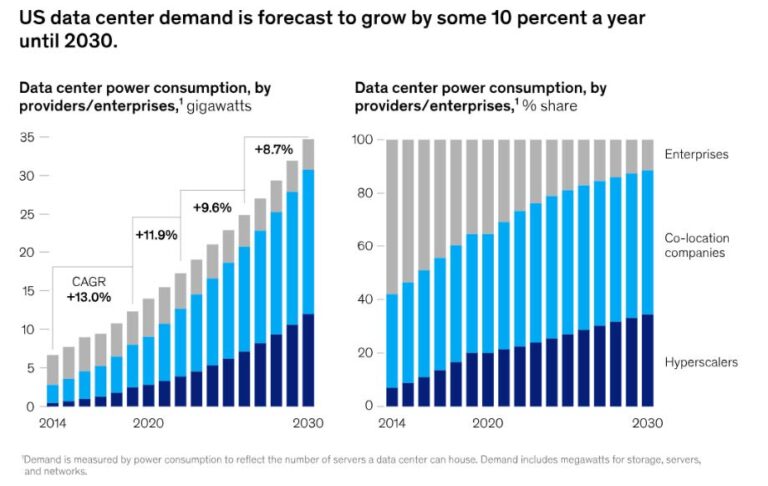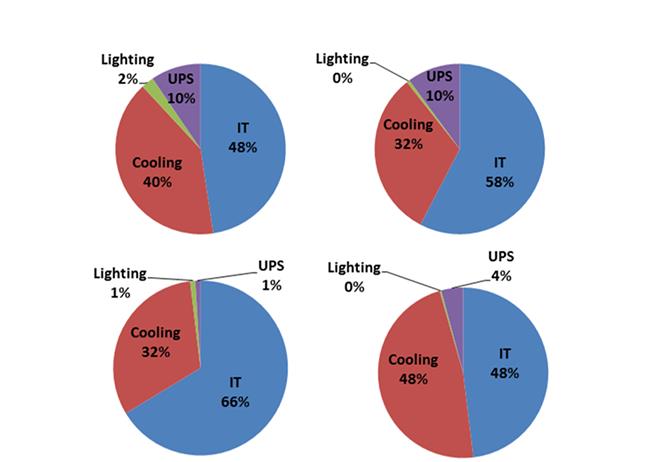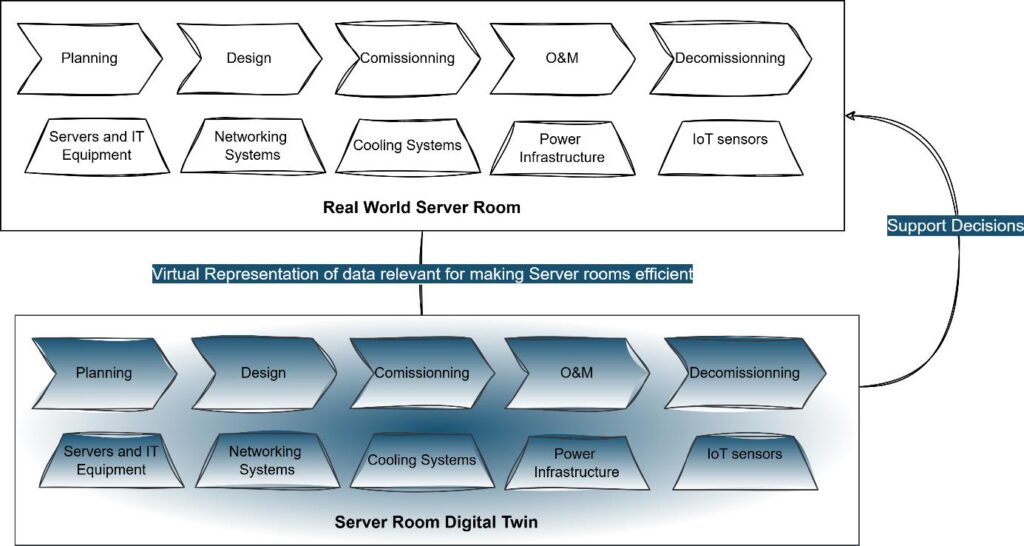The HYCOOL-IT project is geared towards improving the efficiency and management of IT server infrastructures, especially in small server rooms within tertiary buildings such as educational institutions, hospitals, and offices. This initiative aims to address the growing energy demands resulting from the proliferation of edge computing and complex IT applications, which are pushing organizations to bring data processing capabilities closer to the end-users.
R2M within the project has published a report that presented results and analysis of some studies and surveys highlighting the current small scale server room Landscape, existing equipment and processes, common efficiency issues, stakeholder involved and their needs and challenges. The report also shows the HYCOOL solutions such as the use of of BIM Digital Twin to easily plan construction to meet energy efficiency goals in server rooms.
Data centres and server rooms are essential to the global economy, serving as the backbone for digital infrastructure that supports everything from mobile and web apps to AI-based applications like OpenAI’s ChatGPT. These facilities house critical IT infrastructure to build, test, and deliver digital services, including servers, storage systems, and networking equipment. As the demand for digitalization grows, so does the reliance on data centres, making them indispensable to modern businesses and innovations.
The global data centre market was valued at USD 194.81 billion in 2022 and is projected to grow at a compound annual growth rate (CAGR) of 10.9% from 2023 to 2030, with increasing demand driven by the need for more servers, especially in the U.S., where power consumption is expected to reach 35 gigawatts by 2030.

However, despite their importance, data centres are notorious for consuming vast amounts of energy and water. In 2022, global data centres consumed an estimated 460 terawatt-hours (TWh) of electricity, a figure expected to exceed 1,000 TWh by 2026—equivalent to the entire electricity consumption of Japan. Large data centres like hyperscalers can use as much power as 80,000 households, presenting significant environmental and energy challenges and water consumption. This increase in energy consumption not only raises sustainability concerns but also poses threats to energy supply security and economic stability.
To address these issues, various initiatives have been introduced. The European Code of Conduct for Energy Efficiency in Data Centres (EU DC CoC), launched in 2008, is a voluntary program that encourages data centres to reduce their energy consumption. More than 500 data centres have joined the initiative, and those demonstrating significant efficiency improvements are eligible for awards
Hybrid Cooling & Management for IT Infrastructures: The HYCOOL-IT Project

While large-scale data centres owned by corporations have made strides toward energy efficiency, small server rooms face unique challenges. These smaller facilities, typically found in commercial buildings, have decentralized ownership and management, often lacking the motivation to improve efficiency. Despite their smaller scale, they contribute significantly to energy demand, particularly in the services sector, and have historically received little attention in optimization efforts.
They account for approximately 4% of the European Union’s electricity demand in the tertiary sector, accounting for 1.4-1.6% of total EU electricity consumption. The projected energy usage of these small rooms is expected to escalate from 55 TWh in 2010 to about 160 TWh by 2030, underscoring the urgency for energy-efficient solutions.Improving the energy efficiency of small server rooms is crucial, as their role in supporting digital services continues to grow.
To optimize small server rooms’ thermal management and energy efficiency, new expertise and tools are required. The primary objective of the HYCOOL-IT project is to develop standardized methodologies and technological tools to enhance thermal management and energy optimization in IT environments. By implementing advanced technologies such as Building Digital Twins (BDT) and waste heat recovery systems, the project seeks to create cost-effective solutions for energy-efficient server room operations, ensuring they can cope with increasing loads while minimizing environmental impact.
With the right planning, design, and operational strategies, including the adoption of innovative technologies and sustainability standards, it is possible to reduce their environmental footprint and ensure their continued contribution to global digital infrastructure. The report written by R2M for the HYCOOL-IT project aims to present the first analysis based on studies on the topic and the project plan and solutions to meet the energy efficiency target for server rooms in Europe.
The Importance of Small Server Rooms
A server room is a designated space within a building specifically allocated for storing servers and processing equipment on-site to run an organisation’s IT workload and applications. IT equipment and electrical components in server rooms generate a lot of heat. If left unchecked, this heat can have detrimental effects on the performance and stability of the equipment. Keeping the server room environment in best condition is essential for the stability and performance of organization’s IT infrastructure and workload, ensuring data security, and preventing downtime.
Crucial to this maintenance is the cooling system, which ensures precise environmental control within the server room. More specifically, cooling systems for server rooms have three main tasks:
- Temperatures control: Maintenance of stable temperatures in the server room.
- Humidity control: servers do not do well in humid environments.
- Air filtration: dust and other airborne particles can reduce the lifespan and reliability of computing equipment.
According to the study that investigated how IT equipment was deployed, powered, and cooled in small server rooms, cooling systems consume around 25-50% of the energy in server rooms. On average around 40% of energy consumption of the data centres and server rooms can be attributed to the operation of cooling systems with the most efficient cooling systems using 24% of the total energy and the least efficient 61%. Thus, cooling system design plays a pivotal role in the overall efficiency of the data centre and server rooms. Optimizing a cooling system can save power, water, and money for the operator.
Building Digital Twin Integration
A core pillar of HYCOOL-IT is the development of Building Information Modeling (BIM)-based digital twins of IT server rooms. BIM or Building Information Modelling is an intelligent 3D model-based tool that provides a digital representation of the physical and functional characteristics of a facility. It enables the AEC professionals to efficiently plan, design, construct and manage construction projects throughout their life cycle.
The goal of the HYCOOL-IT project is to develop BIM-based building digital twins of server rooms that encompass the whole server room’s infrastructure to support the lifecycle management and optimisation of IT server rooms. These digital models facilitate the monitoring and management of server room infrastructure, offering insights into energy consumption patterns and cooling efficiency. By integrating real-time data from environmental sensors, these digital twins allow for predictive maintenance and operational adjustments that optimize energy use.

Waste Heat Recovery Mechanisms
Waste heat recovery techniques aim to harness the heat generated by server operations, typically released into the environment and contributing to cooling inefficiencies. The waste heat, usually at low temperatures (20°C to 40°C), can be challenging to reuse directly in traditional heating systems.
However, by using technologies like heat pumps or heat exchangers, this low-grade heat can be raised to more useful temperatures or applied directly in systems requiring lower heat, such as pre-heating domestic water or underfloor heating. This process helps repurpose the heat for building heating needs, supporting sustainability goals.
User-Centric Development and Case studies
This report also presents results and analysis of some studies and surveys highlighting the current small-scale server room landscape, existing equipment and processes, common efficiency issues, stakeholder involved and their needs and challenges.
The project emphasizes engaging stakeholders, including facility managers, IT personnel, and maintenance engineers, to derive user stories that highlight their needs and expectations. These narratives ensure that the solutions developed are not only technically sound but also practically applicable in real-world scenarios.
As we face a future increasingly reliant on digital infrastructure, optimizing energy use in IT environments has never been more critical. The HYCOOL-IT project proposes a forward-thinking approach to tackle the energy demands of small server rooms while also aligning with global sustainability efforts. By leveraging innovative technology and engaging key stakeholders in the planning and design phases, it aims to create robust methodologies that can significantly enhance the energy efficiency of IT infrastructures within the tertiary sector.
R2M is happy to contribute to this project with its expertise in Digital twin and exploitation and business model development to ensure the energy transition of pillars place of the digital transformation such as server rooms.

























